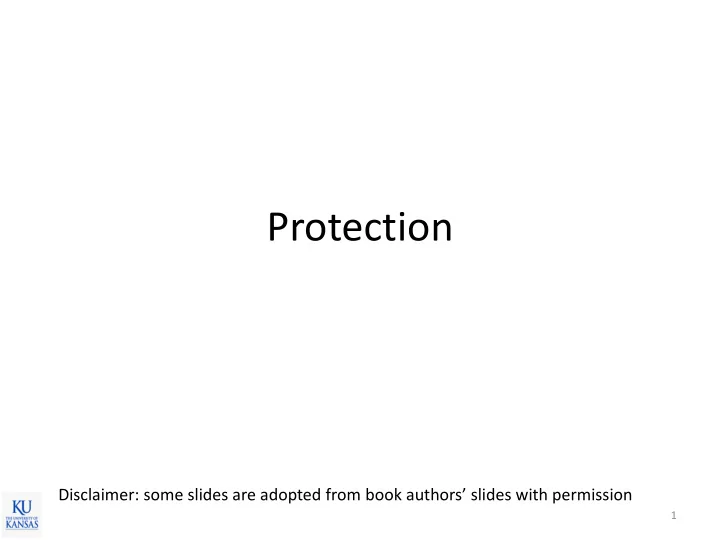

Protection Disclaimer: some slides are adopted from book authors’ slides with permission 1
Recap • Distributed computing – Sharing, performance, reliability • Terminology – Network – Packet – Protocol • DNS – A distributed database of domain name, IP addr. 2
Recap: TCP/IP Protocol Layers HTTP, DNS, SMTP, FTP, … Ethernet 3
Recap: Sending a Packet Source: G. Herrin, Linux IP Networking: A Guide to the Implementation and Modification of the Linux Protocol Stack, 2000 4
Today • Protection • Security 5
Examples of OS Protection • Memory protection – Between user processes – Between user and kernel • File protection – Prevent unauthorized accesses to files • Privileged instructions – Page table updates – Cache/TLB updates 6
Principles of Protection • Principle of least privilege – Programs and users should be given just enough privileges to perform their tasks – Limit the damage if the entity has a bug or abused 7
Protection Domains • Let D i and D j be any two domain rings • If j < I D i D j • Kernel mode vs. user mode 8
Access Control Matrix • Domains in rows – Domain: a user or a group of users • Resources in columns – File, device, … E.g., User D1 can read F1 or F3 9
Method 1: Access Control List • Each object stores users and their permissions -rw-rw-r-- heechul heechul 38077 Apr 23 15:16 main.tex owner group world 10
Method 2: Capability List • Each domain tracks which objects can access – Page table: each process (domain) tracks all pages (objects) it can access 11
Summary • Protection – Prevent unintended/unauthorized accesses • Protection domains – Class hierarchy: root can to everything a normal user can do + alpha • Access control matrix – Domains (Users) Resources (Objects) – Resource oriented: Access control list – Domain oriented: Capability list 12
Security 13
Outline • Security basics • Stack overflow • Some recent security bugs 14
Security • System secure if resources used and accessed as intended under all circumstances – Unachievable • Intruders ( crackers ) attempt to breach security • Threat is potential security violation • Attack is attempt to breach security 15
Program Threats • Stack and Buffer Overflow – Exploits a bug in a program (overflow either the stack or memory buffers) – Failure to check bounds on inputs, arguments – Write past arguments on the stack into the return address on stack – When routine returns from call, returns to hacked address • Pointed to code loaded onto stack that executes malicious code – Unauthorized user or privilege escalation 16
Stack Frame Layout Stack pointer 17
Code with Buffer Overflow #define BUFFER_SIZE 256 int process_args(char *arg1) { char buffer[BUFFER SIZE]; strcpy(buffer,arg1); ... } int main(int argc, char *argv[]) { process_args(argv[1]); ... } • What is wrong in this code? 18
Code with Buffer Overflow #define BUFFER_SIZE 256 int process_args(char *arg1) { char buffer[BUFFER SIZE]; strcpy(buffer,arg1); ... } int main(int argc, char *argv[]) arg1 { process_args(argv[1]); ... } • Stack layout after calling process_arg() 19
Code with Buffer Overflow #define BUFFER_SIZE 256 int process_args(char *arg1) { char buffer[BUFFER SIZE]; strcpy(buffer,arg1); ... } int main(int argc, char *argv[]) arg1 { process_args(argv[1]); ... } • Do you remember strcpy() in C? 20
Let’s Get the Shell • Steps – Compile the code you want to illegitimately execute – ‘Carefully’ modify the binary – Pass the modified binary as string to the process_arg() #include <stdio.h> int main(int argc, char *argv[]) { execvp( ‘‘ /bin/sh ’’ , ‘‘ /bin/sh ’’ , NULL); return 0; } 21
The Attack: Buffer Overflow Before After executing strcpy(buffer, arg1 ) the crafted string containing the illegitimate code 22
Linux Kernel Buffer Overflow Bugs 212 reported buffer overflow bugs in Linux Source: http://www.cvedetails.com/vulnerability-list/vendor_id-33/product_id- 47/cvssscoremin-9/cvssscoremax-/Linux-Linux-Kernel.html 23
Linux Kernel Buffer Overflow Bugs 24
Recommend
More recommend